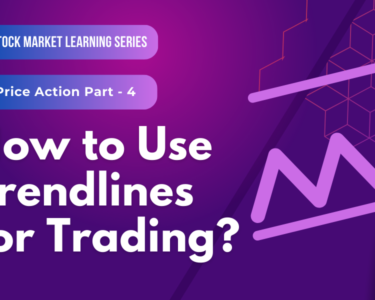This article is part 1 of the Price Action section of our Stock Market Learning series created by SMJ. It offers a clear and straightforward explanation of price action trading, including key strategies used by traders to make informed decisions based on market movements. Our goal is to help beginners understand how to apply price action techniques in their trading and feel more confident navigating the stock market.
Trading involves a significant learning curve and can be challenging to master. It requires time, effort, and consistent practice to develop the necessary skills and understanding. While this series aims to provide valuable insights and guidance, becoming proficient in trading demands dedication and ongoing education.
Price action trading is a method of making trading decisions based solely on the movement of a security’s price over time, without relying on lagging indicators or complex mathematical models.
Traders who follow this approach analyze price patterns, trends, and support and resistance levels directly on charts to predict future market movements. This method is especially popular among short-term traders, such as swing traders and day traders, who need quick insights into price changes.
What sets price action trading apart is its simplicity and flexibility. Instead of following multiple technical indicators that can sometimes contradict each other, price action traders focus on the actual price movements to find high-probability trades.
It’s important to remember that interpreting price action is subjective—two traders might see different patterns on the same chart.
Also read: Mastering Technical Analysis – Understanding the What, Why?
Understanding Price Action
Price action refers to the movement of a security’s price over time, typically visualized through charts that plot these changes. Unlike trading methods that rely on indicators or complex algorithms, price action traders focus on the direct behavior of prices to make trading decisions. It is the foundation of technical analysis and is used to spot trends, breakouts, and potential reversals in the market.
At its core, price action is about analyzing the raw price movements—how the price fluctuates from one period to another and the patterns these movements create. Traders believe that the price itself contains all the necessary information, and by studying it, they can gain insights into the psychology of the market and predict future movements.
Elements of Price Action
Trends
- Uptrend – When prices are consistently making higher highs and higher lows, it signals that the market is in an uptrend. Traders look to buy in an uptrend, capitalizing on the upward momentum.
- Downtrend – A downtrend occurs when prices are making lower highs and lower lows. Traders may look to sell or short the security, expecting the price to continue declining.
- Sideways Trend – When prices move within a horizontal range without clear upward or downward movement, the market is consolidating. Traders often wait for a breakout from this range to enter a trade.
Support and Resistance
- Support – A price level where a falling stock tends to stop and bounce back up. This happens because buyers see value at this level, causing demand to increase.
- Resistance – A price level where a rising stock tends to pause or reverse. Sellers enter the market at this level, increasing supply and driving the price down.
These levels are crucial for price action traders as they help identify potential entry and exit points.
Candlestick Patterns
Candlestick charts are one of the most popular tools for visualizing price action. Each candlestick shows the open, close, high, and low prices for a given period and provides insights into market sentiment.
- Engulfing Pattern – A larger candle “engulfs” the previous candle, signaling a potential reversal.
- Doji – A pattern indicating indecision, where the open and close prices are almost the same, suggesting a potential reversal or continuation.
- Hammer and Hanging Man – These single-candle patterns signal potential reversals based on where they appear in a trend.
Volume as a Confirmation Tool
While price action traders primarily focus on price, volume helps confirm the strength of a trend or breakout. If a breakout from a resistance level occurs with high volume, it suggests strong buying interest and increases the chances of the price continuing higher.
Conversely, low volume during a breakout could indicate that the move is weak and might not sustain.
How Price Action Works in Practice
Imagine a stock listed on the National Stock Exchange (NSE) that has been trading within a narrow range for weeks. A price action trader would draw support and resistance levels around the high and low points of this range.
If the price breaks above the resistance level with strong volume, the trader may interpret this as a bullish signal and enter a long position. However, if the price reverses at resistance and forms a bearish candlestick pattern like the “Engulfing Pattern,” the trader may choose to sell or short the stock.
Price action is all about identifying these key price movements and reacting to what the market is telling you, rather than relying on external factors like earnings reports or economic news.
Subjectivity in Price Action
One challenge with price action is that it can be subjective. Different traders may see different patterns or interpret the same movement in opposite ways. For instance, while one trader might view a price approaching resistance as an opportunity to sell, another could see it as a sign of a potential breakout. The timeframe being analyzed also influences interpretations—a trend on a daily chart might look like noise on an hourly chart.
Price Action vs. Technical Indicators
In the world of trading, two popular approaches dominate the landscape – price action trading and trading with technical indicators. While both methods are widely used, they differ in how traders analyze the market and make decisions. Understanding the differences between these two approaches can help traders determine which style best suits their trading strategy.
What is Price Action?
Price action trading is the study of price movements alone. Traders who follow price action rely on charts showing raw price data, such as candlestick or bar charts, to identify trends, reversals, and key levels like support and resistance. The focus is entirely on how the price moves, with no reliance on indicators or external data.
- Direct Interpretation – Price action traders base their decisions on the real-time movements of a security’s price, reading patterns like head and shoulders, triangles, or candlestick formations (e.g., engulfing patterns, dojis).
- Flexibility – Price action can be applied across all timeframes and is often preferred by short-term traders such as scalpers, day traders, and swing traders who need quick, clear insights into market conditions.
- Example – A price action trader observing a stock on the NSE might notice a “hammer” candlestick forming after a downtrend, signaling a potential reversal. Based on this, the trader may decide to enter a long position without needing further confirmation from any technical indicators.
What are Technical Indicators?
Technical indicators, on the other hand, are tools used by traders to assist in analyzing price data. Indicators are typically based on mathematical formulas applied to past price and volume data to generate signals that can help predict future price movements. These indicators often display as lines or bands on charts and are categorized into types such as trend-following indicators, momentum indicators, volatility indicators, and volume-based indicators.
- Lagging vs. Leading Indicators – Technical indicators can either be lagging (confirming trends after they’ve occurred, e.g., moving averages) or leading (predicting future movements, e.g., Relative Strength Index, RSI).
- Complexity – Indicators often require some understanding of the math behind them. For example, the Moving Average Convergence Divergence (MACD) uses the difference between two moving averages to signal trends or reversals.
- Example – A technical trader might use the 50-day and 200-day moving averages to identify trend direction. If the 50-day average crosses above the 200-day average (known as the “Golden Cross”), it could signal a buy, as it indicates a potential upward trend.
Also read: What are Technical Indicators: Why & How?
Differences Between Price Action and Technical Indicators
Simplicity vs. Complexity
- Price Action – Relies on interpreting raw price movements without adding extra tools. Traders read patterns like double tops, wedges, and pin bars. This simplicity makes it easy to apply across different assets and timeframes.
- Technical Indicators – Often adds complexity by layering calculations on top of price data. Indicators like the RSI, Bollinger Bands, or MACD require traders to understand how the indicator works and what signals to follow.
Real-Time Information vs. Derived Signals
- Price Action – Shows real-time data and provides traders with immediate insight into market sentiment. Since it doesn’t lag, price action gives traders the ability to react instantly to market moves.
- Technical Indicators – Indicators are calculated based on past prices, meaning they may lag behind real-time price movements. For example, a moving average crossover may signal a trend change after the trend has already begun.
Subjectivity vs. Objectivity
- Price Action – Interpretation of price action can be subjective. Two traders analyzing the same price chart may come to different conclusions. For instance, one might see a bullish flag, while another might view the same pattern as a reversal.
- Technical Indicators – Indicators offer more objective signals. A clear buy or sell signal is generated when certain conditions are met, reducing the ambiguity for traders.
Lagging vs. Non-Lagging
- Price Action – Does not lag because it’s based on live price movements. Traders can make decisions immediately without waiting for confirmation from a lagging indicator.
- Technical Indicators – Many indicators are lagging, meaning they react to price movements after the fact. This can sometimes cause traders to enter or exit trades late.
Combining Price Action and Technical Indicators
Many successful traders use a combination of price action and technical indicators. While price action provides the real-time insights and raw data, indicators can help confirm those signals or provide additional context.
Example – A trader may notice a breakout of a resistance level based on price action. To confirm this move, they might check if the RSI is rising, indicating strong momentum. Similarly, moving averages can be used to verify trends spotted through price action alone.
Using Indicators for Confirmation – For instance, a trader who sees a double bottom pattern forming (price action) may look at the RSI to see if it has crossed above 30, indicating bullish momentum.
Managing Risk – Indicators like the Average True Range (ATR) can help traders set stop-loss levels more effectively based on the volatility of the asset, rather than relying solely on price action.
Which Approach is Better?
Neither price action nor technical indicators are inherently superior—each has its strengths and limitations. Traders may choose to focus on price action alone for simplicity and real-time decision-making, while others may prefer the added insights and confirmation provided by technical indicators. The key is finding an approach that matches your trading style, risk tolerance, and goals.
Advantages and Limitations
Price action trading is a popular strategy among traders due to its simplicity, direct approach, and adaptability across different markets and timeframes. However, like any trading method, it comes with its own set of advantages and limitations. Understanding both can help traders make informed decisions and manage their risks effectively.
Advantages
Simplicity and Clarity
Price action trading relies solely on the movement of price, making it easy to understand and apply. Traders don’t need to clutter their charts with multiple technical indicators, which can often lead to confusion. Instead, they focus directly on the price patterns, support and resistance levels, and trendlines.
- Example – A trader can easily spot a clear breakout from a resistance level without needing confirmation from complex indicators.
Real-Time Insights
Since price action trading focuses on current market movements, it provides real-time information about price behavior. This allows traders to react quickly to changes in the market, especially during volatile periods.
- Example – A trader watching an intraday candlestick pattern on the Nifty 50 can make decisions instantly based on the formation of key candlesticks like hammers or engulfing patterns.
Works Across Different Markets and Timeframes
Price action is universal and can be applied to any market, whether it’s stocks, commodities, forex, or indices. Moreover, it can be used across various timeframes, from 1-minute charts for scalping to daily or weekly charts for long-term position trading.
- Example – A swing trader can use price action to spot trends on daily charts of Tata Motors, while an intraday trader can use it on a 5-minute chart of the Nifty 50 index.
No Lagging Indicators
Unlike technical indicators that are often based on past price data and tend to lag behind current price movements, price action gives immediate information. This allows traders to act on the price movements as they happen.
- Example – A trader doesn’t have to wait for a moving average crossover (which lags behind the price) and can make decisions based on immediate breakout patterns or candlestick formations.
Flexibility in Interpretation
Price action allows for flexible interpretation of price movements. Traders can adjust their strategies to changing market conditions without being tied to rigid rules. It enables creative trading approaches like using different chart patterns, timeframe combinations, or risk management techniques.
- Example – A trader could view a particular price action pattern like a “double top” as a potential reversal and apply it across multiple assets, including stocks, indices, or commodities.
Improved Risk Management
Since price action trading focuses on real-time market behavior, traders can implement tight stop-loss orders at logical price levels, such as below a recent support level. This allows for precise risk management and helps minimize losses in volatile markets.
- Example – A price action trader can place a stop-loss just below a recent low point on a support level to control risk in case of a reversal.
Limitations
Subjective Interpretation
One of the major drawbacks of price action trading is its subjectivity. Different traders may interpret the same price movement in different ways, leading to inconsistencies in decision-making. What one trader sees as a potential breakout, another may view as a reversal signal.
- Example – While one trader may interpret a series of lower highs as a bearish sign, another might see it as consolidation before an upward breakout.
No Definite Rules
Unlike strategies that rely on indicators or algorithms with clear, defined rules, price action trading often lacks a strict framework. This flexibility can make it harder for beginner traders to develop a consistent strategy and stick to it.
- Example – A trader who is new to price action might find it challenging to decide when to enter or exit a trade because there are no clear-cut signals compared to an indicator-based strategy like MACD.
Requires Deep Understanding of Market Behavior
Price action trading demands a thorough understanding of market behavior and patterns. It takes time to develop the skills needed to accurately read price movements, recognize patterns, and anticipate market changes. For beginners, this learning curve can be steep.
- Example – Novice traders might struggle to differentiate between a real breakout and a false breakout, leading to potential losses.
Lack of Confirmation Tools
Price action trading relies solely on price movements, without the confirmation provided by technical indicators. This means traders are more vulnerable to false signals or market noise. Without additional indicators, it can be challenging to confirm the strength of a move.
- Example – A trader might see a breakout on a chart but lacks confirmation from an indicator like RSI or MACD, increasing the risk of entering a false breakout.
Emotional Influence
Since price action trading requires close monitoring of the market, traders may become emotionally involved in their trades. Watching every price movement in real time can lead to impulsive decisions driven by fear or greed, especially during volatile market conditions.
- Example – A trader might exit a trade too early due to fear of a reversal, even though the price action shows that the trend is still intact.
Limited Consideration of External Factors
Price action trading does not take into account macroeconomic factors, news events, or fundamental analysis that can significantly affect price movements. Solely focusing on price can sometimes lead to missed opportunities or unforeseen market movements.
- Example – A company’s stock may show strong bullish price action, but negative news or poor earnings results could lead to a sharp decline, catching the price action trader off-guard.
This article is a foundational step in understanding price action trading in the Indian stock market. While we strive to provide accurate and up-to-date information, investing in the stock market involves significant risks, and there are no guarantees of profit. The value of investments can rise or fall, and you may not get back the amount you originally invested.
The strategies and examples mentioned in this article are for educational purposes only and should not be considered investment recommendations. We do not recommend specific stocks, companies, or financial strategies, nor do we encourage making investment decisions without thorough research and understanding.
It is crucial to conduct your own research or consult with a financial advisor to tailor your investment strategy to your goals and risk tolerance. Follow the entire series to build a comprehensive understanding and become a knowledgeable investor. Always invest wisely and consider your financial objectives and risk appetite before making any investment decisions.





